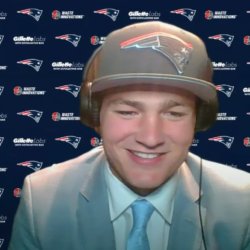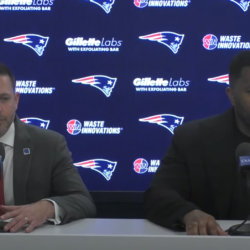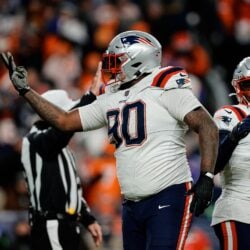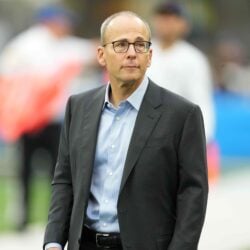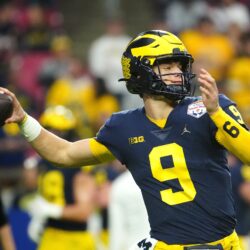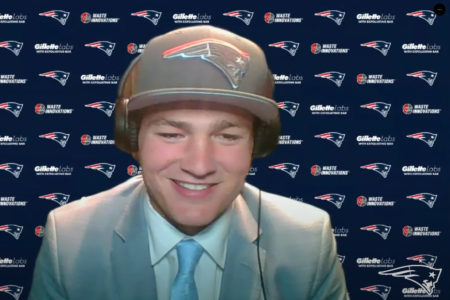A historical look at the uniform numbers for the new Patriots: #42, Travis Hawkins
A historical look at the uniform numbers for the new Patriots: #42, Travis Hawkins
Here is the fourteenth in a series of historical perspectives on who has previously worn the uniform number of the 2014 additions to the roster of the New England Patriots. Unless noted otherwise all the players listed took part in at least one regular or playoff game in the season listed for the Patriots.
Travis Hawkins is the latest members of the Pats to don the number 42; below is a look at those who have preceded them to wear that jersey over the years during the franchise history of the Patriots. For anybody that first thought of Mack Herron or Ronnie Lippett, congratulations on your loyalty and continuing fandom - though you are showing your age in comparison to those that first thought of BenJarvus Green-Ellis.
42 – Cornerback Travis Hawkins
- Hawkins transferred to Delaware after two years at Maryland. With the Blue Hens he recorded 168 tackles, eight interceptions and 20 passes defensed, while also returning kicks and playing on special team coverage units. Hawkins may eventually carve out a niche for himself in the NFL as a special teams ace, but more realistically he will start out the season on the practice squad.
2008-11: RB BenJarvus Green-Ellis
- Despite posting solid numbers (4,185 yards, 26 TD) during his college career, The Law Firm went undrafted thanks in part to mediocre combine numbers and never being part of the passing game. The Patriots signed him as an undrafted rookie out of Ole Miss in 2008, but he was cut at the end of training camp. The Pats signed him to the practice squad and promoted him to the 53-man roster in October, and immediately scored in four straight games.
In 2009 BJGE was almost strictly a special teams player, and was inactive for four games plus the playoff game against Baltimore. However in the next off season he had shown enough that the Patriots were comfortable in trading Laurence Maroney, with the idea that BJGE could replace his snaps as the third running back on the depth chart. Playing time changed a lot more than anticipated, as Green-Ellis and Danny Woodhead carried the load due to injuries to Fred Taylor and Kevin Faulk. The Law Firm rushed for 1,008 yards and 13 touchdowns. He had a streak of five games with at least one touchdown (third longest in club history). Most impressively, Green-Ellis did not fumble the ball a single time; in fact, he would not fumble in the NFL until 2012.
In 2011 Law Firm battled a turf toe injury all season, and although he rushed for 11 touchdowns, his yards per carry dropped from 4.4 to 3.7. After having drafted Stevan Ridley and Shane Vereen, the Patriots elected to let BJGE depart as a free agent. He has rushed for 1,850 yards and 13 touchdowns in two seasons with the Bengals, but his playing time in 2014 with Cincinnati may dwindle between the breakout season of Giovani Bernard, and the addition of rookie Jeremy Hill at running back.
Green-Ellis rushed for 29 career touchdowns with the Patriots, which ranks as the seventh most in franchise history. His 2,064 yards is 18th all-time for the club, and he is one of only twelve players to rush for 1,000 yards in a single season for the Patriots, and his 4.0 yards per carry ranks as ninth best in team history among those with at least 450 carries.
2004: S Dexter Reid
- In his final two years at North Carolina, Reid racked up 298 tackles and was a first team All-ACC player both seasons. The Patriots drafted him with the 113th overall pick in the fourth round of the 2004 draft.
Reid played in 13 games plus all three playoff games, on special teams as well as in nickel and dime formations. He was a big hitter, but a liability in coverage. In the Super Bowl against Philadelphia he was beaten for two touchdowns, once badly by Greg Lewis when the Patriots were trying to run down the clock. Between being outplayed by James Sanders and slowed down with injuries, Bill Belichick pulled the plug and released Reid at the end of training camp in 2005. He finished his one-year career as a Patriot with 13 games, two starts, 15 tackles, two passes defensed, one forced fumble, one fumble recovery, and one Super Bowl ring.
The Colts claimed Reid off waivers the following day, and he spent two seasons with Indianapolis - primarily on special teams - and got himself a second ring following the 2006 season.
In the weeks that followed that Super Bowl, Reid's life came tumbling apart. He was arrested three times, with charges ranging from felony possession of drugs with intent to distribute to illegal firearms. Later in 2007 Reid proved he was not the sharpest blade in the drawer when he drew attention to himself by parking in a handicap spot in front of a Chick-fil-a during the noontime rush; the end result was an arrest for possession of a loaded AK in the vehicle, and an arrest on a fugitive warrant from previous gun charges. Another time he was pulled over for driving erratically; he told the police officer it was because he was texting, but apparently forgot that he had three ounces of weed in full view in the back seat.
Reid was initially sentenced to two years in jail, but a forgiving judge reduced that to a suspended sentence based on his staying out of trouble for two years, along with three years of probation. Reid was able to do just that, but his NFL career was over. In 2011 Reid tried out for the Marty Schottenheimer's Virginia Destroyers of the UFL, but at the age of 30 and five years removed from playing competitive football, he did not make the roster.
1997-99: S Chris Carter
- Carter attended the University of Texas, where he set a school career record with 348 yards on interception returns, on 14 picks. The Patriots chose him with the 89th overall pick in the third round of the 1997 NFL draft.
In his rookie season he appeared in all 16 games, almost exclusively on special teams. The next year he finished second on the team with 20 special team tackles, again appearing in all 16 games. In 1999 he took over as the starting free safety, and was second on the Pats with three picks, and was fourth with 94 tackles.
On July 15, 2000, Carter was re-signed, part of an announcement that included a skinny rookie quarterback from Michigan. He was released at the end of training camp, and picked up off waivers by Cincinnati. Carter spent two seasons with the Bengals and one with Houston, finishing his NFL career in 2002.
Carter appeared in 47 games with 15 starts in his three seasons with New England; he had three interceptions and two fumble recoveries with the Pats. Overall he appeared in 92 NFL games with 29 starts, with five interceptions, two forced fumbles and five fumble recoveries.
1993-94: S Harlon Barnett
- Barnett was drafted in the fourth round, 101st overall in the 1990 draft by the Cleveland Browns. He played 38 games with ten starts in three seasons with the Browns before Bill Belichick cut him after week one - allegedly with the idea of re-signing him - and Bill Parcells claimed him off waivers. The 1993 Patriots were in disarray in the backfield, and Bennett started 12 games in '93, and then all 16 games in '94. He then played two years with Minnesota, finishing his NFL career with 99 games and 53 starts, 264 tackles, four interceptions, three forced fumbles and three fumble recoveries.
In two seasons with the Patriots Barnett made 120 tackles with four interceptions, two fumble recoveries and two forced fumbles. He started in 28 of the 30 games he played for the Patriots, plus one playoff game.
Barnett was a captain and All-American at Michigan State, and after retiring from pro football he eventually returned to East Lansing. Since 2007 he has been the Spartans' secondary coach, leading that unit to be one of college football's top defensive units during his tenure.
What Barnett is probably most well known for though, is being made to look foolish by Barry Sanders. Barnett is number 42 in the video clip:
1983-91: CB Ronnie Lippett
- Being selected in the 8th round, 214th overall in the 1983 draft, expectations for Pats fans for the University of Miami Hurricane were rather low. It turned out that pick was one of the best values in franchise history, as Lippett went on to start 111 games at left corner for the Patriots, and earn a place on the 1980s All-Decade Team.
Lippett won the starting job as a rookie, capably taking over the position vacated by the departure of hall of famer Mike Haynes, and leading the team with 26 passes defensed. In 1985 he played in all 20 games for the Pats and had two interceptions plus two passes defensed in the 27-20 road playoff victory over the Raiders. Lippett followed that up with eight picks in 1986, third most in the NFL that season. In 1987 he returned two interceptions for touchdowns to lead the NFL in that category.
After rupturing his Achilles tendon in the preseason in 1989, it looked like Lippett's career was over. At the age of 30 he bounced back though, and had four interceptions and four fumble recoveries while starting every game for the Pats.
Lippett played one more season and finished his career with 24 interceptions for the Patriots, which is eighth most in franchise history. He played in 122 games with 11 starts, plus four starts in the playoffs. Since then Lippett has been active with charitable organizations and working with at-risk youths in the local area.
1987: S Ron Shegog
- Shegog went undrafted by the NFL out of Austin Peay State, but was selected by the Birmingham Stallions in the fourth round of the USFL's 1986 draft, 28th overall. Unfortunately that was the year that Donald Trump and Eddie Einhorn convinced the other USFL owners to play in the fall rather than the spring, and the season never kicked off. Shegog played in each of the three replacement games for the Patriots during the 1987 strike, and had an interception in the Patriots 21-7 victory at Houston. He also played for the Denver Dynamite of the Arena Football League in 1989.
1973-75: RB/KR/PR Mack Herron
- 'Mini-Mack' Herron was born in 1948 in Biloxi, Misssissippi, and grew up in the slums of Chicago. Due to poor grades he was unable to get into any Division 1 schools, so he enrolled at Hutchinson (Kansas) Junior Coolege, where he scored 41 touchdowns and twice has five TDs in a single game. Herron was a second team All-American, and also won the national junior college 100-yard dash title, and then transferred to Kansas State. Despite having to split touches with future NFL players Larry Brown (Redskins), Mike Montgomery (Cowboys) and Lynn Dickey (Oilers), Herron scored 27 touchdowns in two years and led the Big Eight with 52 receptions in 1969; if he had been given more playing time he would have been a legitimate Heisman Trophy candidate. Herron set several K-State records during his brief career as a Wildcat, including most points in a season (126), most career points (188), and most career touchdowns (31).
Because of his small stature - Herron was just 5'5", weighing 170 pounds - NFL teams wrote him off before the draft. Atlanta selected him in the sixth round, 143rd overall in the 1970 draft, but that was not meant to be. Herron said that Falcon head coach Norm Van Brocklin (who had two winning seasons in 13 years as a head coach) “told me I had a bad attitude and might as well not come to camp. He had all these dress codes and all. He was trying to take away a man’s freedom. He never really evaluated people either. He has a preconceived idea about people before he ever saw them play. I never had a chance.” Herron turned down Atlanta's contract offer that included no signing bonus and no guaranteed money, and eventually headed north to the Canada.
In 1971 Herron signed with the Winnipeg Bombers, and was an instant success in the CFL. In his rookie season he was an All Star after rushing for 900 yards, adding 426 more on 36 receptions and another 1019 yards on 35 kickoff returns. As good as that was, the next year he was even better. Herron rushed for 1,527 yards, caught 39 passes for 451 yards, added 552 on kickoff returns, and scored 17 touchdowns. That season he was an All-Canadian selection, which is comparable to being a first team All Pro.
However, in May of 1972 what would turn out to be a recurring theme for Herron played out. Winnipeg police raided his apartment where they tackled Herron before he could toss evidence - a small amount of marijuana - off his balcony. After a search the police also found traces of cocaine, and the Bombers released him. Five months later Herron plead guilty to two drug-possession charges and was given a choice: four months in jail or pay a fine and costs totaling $1,000.
With his pro football days apparently behind him, Herron moved back to Chicago to get on with his life. As luck would have it a former college assistant coach, Dick Steinberg, was now a scout for the Patriots, and he hunted Herron down; Steinberg found him earning a paycheck selling jeans. The Pats were a team in transition: under new coach and general manager Chuck Fairbanks, they were completely turning the roster over, at one point making 27 waiver claims in one three-day period in their desperate search for talent. Fairbanks had no problem giving Herron an opportunity with a team that had gone 3-11 under Phil Bengston and John Mazur the previous season.
In his first NFL season Herron was used primarily as a return specialist. He led the NFL with 1,092 kick return yards in 1973, averaging 26.6 yards per return. Herron averaged an NFL-best 12.5 yards per touch that year, and was second in the league with 1,839 all-purpose yards. Between his electrifying style of cutbacks and a size that fans (especially kids) could relate to, Herron immediately became a fan favorite.
The following season was one for the ages. Herron became a regular in the backfield alongside Sam Cunningham, and the Patriots jumped out to a 5-0 record to start the season. Herron had one of the best seasons by an individual player in league history, shattering the great Gale Sayers' single-season record for all-purpose yards that had been set back in 1966. Herron led the Patriots with 824 yards, caught 38 passes for 474 yards, was second in the NFL with 517 yards on punt returns, and scored twelve touchdowns, totaling 2,444 all-purpose yards. Though the Pats faded in the second half of the season due to too many key injuries, the region had become excited about the team - in large part due to Herron's play.
Sadly, things spiraled out of control the following season. There were rumors of heavy drug use, with the final straw allegedly being a late-night birthday party that Herron threw for Leon Gray on a Friday night/Saturday morning before the Patriots were scheduled to play Dallas on Sunday. The Patriots released him, and after Atlanta picked him up for the final four games of the 1975 season, his NFL career was over.
Herron has reportedly been arrested 20 times, most recently three years ago for possession of heroin. In 1978 he was sentenced to five years on cocaine trafficking charges, was sentenced again to four years in prison in 2000, and served nine months in prison in 2003. He has diabetes, and ankle and leg ailments that are so bad that he sometimes can hardly walk due to the constant pain. Herron has attempted to get help from the NFL, but has been stymied due to his short career.
Herron was named to the 1970s Patriots All-Decade Team despite being on the club for just two and a half years. During the 1973 season he set eight club return records, then set nine team records in 1974. In franchise history he ranks tenth with 1,796 kickoff return yards, tenth with 71 kickoff returns, and ninth with an average of 25.3 yards per return. He is second in club history with a 12.0 yard average on punt returns, and ninth in both punt return yards (888) and number of returns (74). Herron is also 23rd in team history with 1,298 yards rushing, and on the club's all-time leader board with 96 points scored. In all Herron had 4,771 all-purpose yards in just 35 games with the Patriots. His 2,444 all-purpose yards in 1974 is the most ever in the NFL in a 14-game season, and is still the sixth highest single-season total in NFL history.
1962-71: CB/S Don Webb (wore 48 in '61)
- After averaging 5.2 yards per carry at wingback as a sophomore, Iowa State converted Webb to end for the 1959 season. In his junior year he led the conference in receptions, receiving yards and yards per catch, and was a first-team All-Big Eight selection; the next season led the Big 8 in receiving touchdowns. The Patriots then selected him in the 24th round, 186th overall in the 1961 draft.
The Pats moved him to defense and he not only made the team, but was the starter at left corner his rookie season. He made an immediate impact, leading the AFL with four non-offensive touchdowns: a fumble, a blocked punt, and two picks. He had five interceptions on the season and was a one-man show in the season finale at San Diego where he had a 31-yard pick six to put the Pats up 17-0 in the first quarter, and then finished off scoring with a 20-yard return of a punt for another score. The Pats won 41-0 to finish 9-4-1, but Houston's victory over the Raiders the same day gave the Oilers ten wins and the AFL East crown, and a trip to the league championship game.
Webb lost his starting position to Chuck Shonta the following year, but still played in all 14 games. He missed the entire 1963 season with a knee injury suffered just prior to the start of the season, but bounced back by reclaiming his starting position and recording six interceptions in 1964. He was considered one of the hardest hitters in the league, and in 1967 was converted to safety, a position that better suited his skills. In 1969 he was named the team's Unsung Player of the Year and was an AFL All-Star, and was annually among the top three in voting for team's Most Valuable Player. Webb remained a starter until 1971, was named a member of the Patriots All-Decade Team for the 1960s. His 21 career interceptions was second most in club history at the time he retired, and over 40 years later he still ranks 11th all time in that category, as well as 8th in interception return yards. He finished his career with 134 games played, which at the time was second only to Houston Antwine's 142 games played, and still places him in the top 30 all time in club history.
1960-61: DB Bob Soltis
- Perhaps his biggest claim to fame may be that he was part of the impetus that led to Gino Cappelletti deciding to tryout for the Boston Patriots. After Cappelletti heard that Soltis and two other college football teammates (Bobby Cox and Gordy Holz) had been contacted by Lou Saban for tryouts, Cappelletti decided that at age 26 perhaps he was not too old to play pro football, and got a hold of Saban and got himself an audition with the Pats.
On a bad (1-8) 1958 UM team, Soltis was a halfback who was second on the roster with 424 yards from scrimmage and - incredible as this may sound today - led the Gophers with 11 receptions. The New York Giants drafted him in the 16th round, 190th overall in the 1959. That '59 club was very good - they were in the midst of a run when they went to the championship game five times in six seasons - and Soltis was relegated to the taxi squad, but was never on the full roster.
Soltis converted from offense to defense and played all 14 games in the inaugural 1960 AFL season for the Patriots, and three more in 1961 before the effects of a back injury suffered in the preseason sidelined him and ended his playing days; he finished his career as a Patriot with two interceptions for 33 yards in seventeen games played. He then went on to join what was then a very new industry, and had a very lengthy and successful post-football career in computer sales and management. He passed away in his native Minnesota at the age of 79 on June 26th, 2009.
Previously:
#29 - RB Roy Finch and CB Malcolm Butler
#35 - RB Jonas Gray and CB Daxton Swanson
Follow on Twitter @AllThingsPats
2014 NFL Calendar and Key Dates for the New England Patriots



